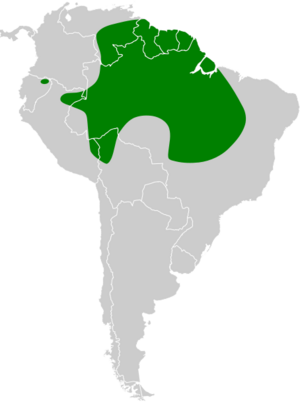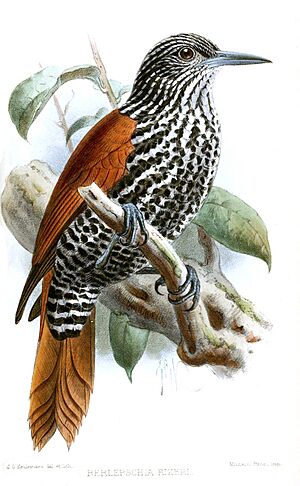Point-tailed palmcreeper facts for kids
Quick facts for kids Point-tailed palmcreeper |
|
|---|---|
 |
|
| Conservation status | |
| Scientific classification | |
| Genus: |
Berlepschia
|
| Species: |
rikeri
|
 |
|
| The range on this map is incomplete; it does not extend far enough west. See that in xeno-canto [1]. | |
The point-tailed palmcreeper is a special kind of bird. It's also called the palmcreeper. This bird lives in many countries in South America. You can find it in places like Bolivia, Brazil, Colombia, and Peru. It belongs to a bird group called the ovenbird family.
Contents
About This Bird
The point-tailed palmcreeper is the only bird in its group, called a genus. This means it's quite unique! It doesn't have any different types or subspecies.
A scientist named Robert Ridgway first described this bird. He later created a new group just for it. He named the group Berlepschia to honor another bird expert, Hans von Berlepsch. Mr. Berlepsch noticed how different this bird was from others. The second part of the bird's name, rikeri, honors C.B. Riker. He was the one who collected the first bird that Ridgway used to study and describe the species.
What It Looks Like
The point-tailed palmcreeper is a medium-sized bird. It is about 18 to 22 centimeters (7 to 9 inches) long. It weighs about 32 to 37 grams (1.1 to 1.3 ounces). Both male and female birds look the same.
Its face has thin black and white stripes. Its head and upper back also have black and white stripes. These stripes turn into "teardrop" shapes on its back. The lower part of its back and its tail are a bright reddish-brown color. Its tail feathers are pointed and stiff at the bottom.
The bird's wings are also reddish-brown. Its flight feathers are dark, almost black. The feathers on the back of its wings have reddish-brown edges. Its throat is white with long black stripes. Its chest has wide black and white stripes. These stripes become less clear on its belly. The feathers under its tail have black and white bars.
Its eyes are orange-brown. Its beak is gray, and its legs and feet are also gray. Young palmcreepers look a bit different. They have small black dots on their white throat. Their chest has spots instead of stripes.
Where It Lives
The point-tailed palmcreeper lives in many parts of South America. You can find it from southern Venezuela all the way to northeastern Brazil. It also lives in southeastern Colombia, eastern Ecuador, and eastern Peru. It goes south into northern Bolivia and across the Amazon region of Brazil.
This bird mostly lives in swamps where a type of palm tree called Mauritia grows. Sometimes, it lives in areas with other kinds of palm trees too. These swamps can be in forests that stay green all year or in grassy areas called savannas. It usually lives below 400 meters (1,300 feet) in height. But in Ecuador, it can be found as high as 650 meters (2,100 feet).
Bird Behavior
Movement
The point-tailed palmcreeper stays in the same area all year long. It does not migrate to other places.
What It Eats
This bird eats small bugs and spiders. Scientists have seen it eating beetles, true bugs, ants, and spiders. It almost always looks for food in pairs.
It is very good at moving around on palm branches. It picks food from the branches and leaves, especially near their bases. It uses its stiff tail to help it balance. Sometimes, it even hangs upside down to find food!
Reproduction and Life Cycle
Scientists think that point-tailed palmcreepers stay with one partner for life. The time when they have babies is not fully known. But in some parts of Brazil, it seems to be from July to November.
One nest was found built from sticks. It was hidden inside the dead leaves of a Mauritia palm tree. We don't know how many eggs they lay. We also don't know how long the eggs take to hatch or when the young birds leave the nest. Details about how the parents care for their babies are also still a mystery.
How It Sings
The song of the point-tailed palmcreeper is loud and fast. It's a series of 20 to 30 short, sharp notes. The notes usually stay at the same pitch. Sometimes, they go up a little and then come down at the end. People have described its song as "ka-koo, didididididididididi" or "dedede-kee!-kee!-kee!-kee!-kee!-kee!-kee!-kee!". Another way to describe it is "weet-weet-witwitwit---".
Status and Protection
The IUCN (International Union for Conservation of Nature) has looked at the point-tailed palmcreeper. They say it is a species of "Least Concern." This means it is not in immediate danger of disappearing. It lives in a very large area. Even though we don't know exactly how many there are, the number of birds seems to be steady.
No big threats have been found for this bird right now. It is considered rare to uncommon. Its home, the palm swamps, is usually safe from most human activities. This bird also lives in several protected areas.



